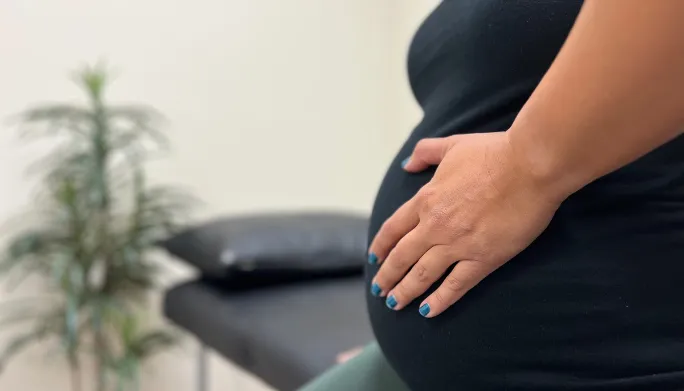Pregnancy & Postpartum
Birth Prep
Preparing for labor and delivery can feel overwhelming, but our team is here to help. We offer a variety of services to help you feel ready for the big day, including teaching proper breathing techniques, labor positions, how to push properly, and pain management strategies. Additionally, we can provide guidance on the use of birthing tools like birthing balls and TENS units.

VBAC Prep (Vaginal Birth after C-section)
Pelvic floor therapy can play a crucial role in preparing for a vaginal birth after cesarean (VBAC). Our therapists can assess the muscles of the pelvic floor to ensure there are no issues that may impede effective pushing during delivery. We also address any residual scar tissue along the cesarean scar and surrounding abdominal tissues, which can improve pelvic floor function and motor control.
Additionally, we provide education on proper pushing techniques and strategies, including the phases of labor, timing for an epidural, and effective positioning to assist with cervical dilation and the descent of the baby. Through an internal pelvic floor muscle assessment, we can also help improve the effectiveness of pushing without placing unwanted strain on the pelvic floor muscles and perineum.
Diastasis Recti
Diastasis Recti is a common condition that affects women both during and after pregnancy. This is caused by the separation of the rectus abdominis muscles, due to the stretch placed on the muscles as baby grows. The abdominal muscles and connective tissue that supports them both stretch during pregnancy, and can lead to weakness in the midsection. To improve strength, control, function, and proper pressure management of the abdominal wall and core as a whole, pelvic floor therapy is safe and effective.
C-Section Rehab
Pelvic floor therapy can be a powerful tool in addressing the pain and discomfort that can occur after a cesarean delivery. Our experienced therapists use a variety of techniques, including manual therapy, scar tissue mobilization, myofascial release, and stretching and strengthening exercises, to help reduce pain at the incision site, normalize pelvic floor muscle tone, decrease tissue hypersensitivity, improve core and back muscle strength, and retrain muscles affected by pregnancy and delivery for optimal function.
Whether you had your c-section recently or years ago, pelvic floor therapy can help you achieve greater mobility, function, and strength in the abdominals, back, and pelvic floor. Don’t let pain hold you back, contact us today to learn more about how we can support you on your recovery journey.
Return to Exercise Postpartum
Exercise after giving birth is part of a healthy lifestyle. Postpartum exercise has been shown to be beneficial at all stages of life. There are many benefits to postpartum exercise:
- Tone and strengthen your abdominal muscles
- Boosts energy
- May help prevent postpartum depression
- Improves sleep quality
- Relieves stress
- Can help you shed any extra weight you might have gained during pregnancy
It is difficult to make the necessary adjustments when you become a mother. The internet can also be confusing and overwhelming with information about postpartum exercise. Let’s talk about returning to exercise after childbirth.
Pelvic Organ Prolapse
POP (pelvic organ prolapse) refers to the prolapse of the pelvic organs such as the bladder, uterus, and/or rectum. Prolapse can be caused by a variety of factors, however pelvic floor therapy can be very effective for many women.
Pelvic floor therapy can reduce symptoms and prevent the condition from getting worse. It can be a wonderful, safe, and effective option other than surgery. Book an appointment with Bliss Pelvic Health to learn more about pelvic organ prolapse, symptoms to look out for, and what treatment options are available. We are happy to help you with any questions that you may have!
Symphysis Pubis Dysfunction (SPD)
The pubic symphysis is a cartilaginous joint that connects your right and left pubic bones. Symphysis Pubis Dysfunction, otherwise known as SPD, can occur when there is a decrease in joint stability causing pubic bone pain. SPD is common during pregnancy and can present postpartum as well.
A comprehensive orthopedic and pelvic floor assessment can identify Symphysis Pubis Dysfunction. Our pelvic floor therapists use gentle, effective techniques to reduce pain, increase stability, improve strength, and increase function. We provide instruction on how to maintain good body mechanics and prevent injury or reaggravation of symptoms in the future. Other areas that offer treatment and care includes:
- Support and care during pregnancy/postpartum
- Staying active during pregnancy
- Return to exercise
- Performance

Urinary Incontinence
Urinary Incontinence is the unwanted loss of urine. Urinary incontinence can present as leaking urine from coughing, laughing, sneezing, or jumping. This is called Stress Urinary Incontinence. Urinary Incontinence can also occur when you get the urge to go to the bathroom and may have to rush in fear you won’t make it in time. This is called Urge Urinary Incontinence.
You may experience one or both of these types of Incontinence. Our pelvic floor therapists are highly trained and have extensive experience treating all forms of urinary incontinence during both pregnancy and postpartum. You don’t need to suffer unnecessarily with unwanted urine leakage at any point throughout your life. Reach out to us today to get started on your healing journey.
Painful Intercourse
Pelvic floor therapy is an effective treatment for reducing or eliminating sexual and vaginal pain. Our safe, gentle techniques focus on addressing the underlying causes of pain and discomfort, helping women to experience pain-free, enjoyable intercourse.
Our therapists work to reverse issues and unravel the web of pain by increasing pelvic blood flow, releasing trapped nerves and adhesions (scar tissue), relaxing and stretching tight tissue, correcting postural imbalances, restoring mobility, and melting away painful tender points and trigger points. Our goal is to tone and strengthen the pelvic floor muscles, restoring overall health and function to the pelvis.

SI Joint Dysfunction
Sacroiliac Joint (SIJ) dysfunction, a lower back/pelvic condition, can be caused by joint stiffness (hypomobility), or slackness (hypermobility), at the sacroiliac bones in the pelvis. This condition can affect men and women of any age, but it is more common in females. Patients suffering from SI joint pain may find pelvic floor therapy at Bliss Pelvic Health beneficial. Your pelvic floor therapist will evaluate your SI joint dysfunction to determine an individualized treatment plan for you.
Low Back Pain
Your pelvis and tailbone are supported by muscles that include your back muscles, core muscles, hip muscles, and a small group of muscles located at the base of your pelvis called your pelvic floor muscles. If you are not getting these evaluated, you are missing an important piece of the puzzle to your low back pain.
We’ve known for a long time that low back pain and the pelvic floor are closely related. Many of our patients notice sciatica and other low back symptoms but they don’t realize that it could be due to their pelvic floor until they have their initial evaluation. To provide sustained relief from lower back pain, it is important to examine both the pelvic floor as well as the lower back.
Hip Pain
A pelvic floor specialist might be able to help you if you have hip pain as the muscles of your hip are directly connected to your pelvic floor. Your hip muscles, pelvic floor muscles and core muscles must all work together to allow your body to move efficiently. Each muscle group should be strong and flexible. Your body could rely on the other muscles for stability or movement, eventually causing more pain or dysfunction. To determine if the primary cause of hip pain is in one of these areas, a pelvic floor therapist can perform an internal assessment. An individualized plan can restore mobility, stability, function, and functionality of the pelvic floor and other hip muscles. You can return to the activities that you love by correcting any underlying muscle imbalances.
Tailbone Pain
Tailbone pain, also called Coccydynia, can be treated by our expert pelvic floor therapists. Coccydynia is the pain from the small bone just above your anus at the end of your spine. It can be quite painful! This is a common problem that we treat all the time. Coccydynia can affect women of all ages and we can help them get the correct pelvic floor therapy treatment to resolve their pain. Don’t let your tailbone pain get you down. Let’s make you feel better! Schedule your appointment today.


